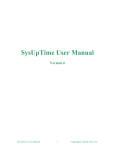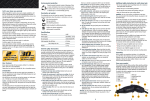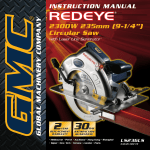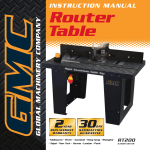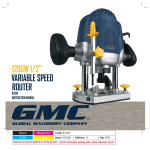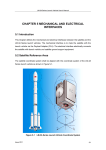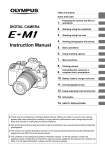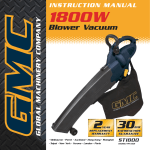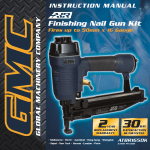Download Global Machinery Company 1050W User's Manual
Transcript
I N S T R U C T I O N M A N UA L 1050W Powered Router Table • Melbourne • Perth • Auckland • Hong Kong • Shanghai • Taipei • New York • Verona • London • Paris PRTABLE 031219 ED12 DR Contents Description of symbols Dear Customer The rating plate on your tool may show symbols. These represent important information about the product or instructions on its use. Wear hearing protection. Wear eye protection. Wear breathing protection. If you require any help with your product, whether it is a Warranty claim, spare part or user information, please phone our Help Line for an immediate response. Phone 1300 880 001 in Australia or 0800 445 721 in New Zealand. Introduction Double insulated for additional protection. Your new GMC power tool will more than satisfy your expectations. It has been manufactured under stringent GMC Quality Standards to meet superior performance criteria. You will find your new tool easy and safe to operate, and, with proper care, it will give you many years of dependable service. Caution. Carefully read through this entire Instruction Manual before using your new GMC Power Tool. Take special care to heed the Cautions and Warnings. Your GMC power tool has many features that will make your job faster and easier. Safety, performance, and dependability have been given top priority in the development of this tool, making it easy to maintain and operate. Conforms to relevant standards for electromagnetic compatibility. Specifications Nominal voltage: 230–240Vac ~ 50Hz Power: 1050W No load speed: 8000-30000 RPM Collet capacity: 1/2” (12.7mm) and 1/4” (6.35mm) Cutting depth: 36mm Spindle lock: Yes Insulation: Double insulated Variable Speed Settings Dial Indication Speed (RPM) 1 8000 2 14000 3 19500 4 24500 5 27500 6 30000 Note. These speeds are approximate values (within 20%) and are for reference purposes only. Environmental protection Recycle unwanted materials instead of disposing of them as waste. All tools, hoses and packaging should be sorted, taken to the local recycling centre and disposed of in an environmentally safe way. 3 General safety instructions 5. Do not force the tool. The tool will do the job better and safer working at the rate for which it was designed. 6. Use the correct tool for the job. Do not force small tools or attachments to do the job best handled by a heavier duty tool. Never use a tool for a purpose for which it was not intended. 7. Dress correctly. Do not wear loose clothing or jewelry. They can be caught in moving parts. Rubber gloves and non-slip footwear are recommended when working outdoors. If you have long hair, wear a protective hair covering. 8. Use safety accessories. Safety glasses and earmuffs should always be worn. A face or dust mask is also required if the drilling operation creates dust. 9. Do not abuse the power cord. Never pull the cord to disconnect the charger from the power point. Keep the cord away from heat, oil and sharp edges. 10. Secure the work piece. Use clamps or a vice to hold the work piece. It is safer than using your hand and frees both hands to operate the tool. 11. Do not overreach. Keep your footing secure and balanced at all times. 12. Look after your tools. Keep tools sharp and clean for better and safer performance. Follow the instructions regarding lubrication and accessory changes. Inspect tool cords periodically and, if damaged, have them repaired by an authorised service facility. Inspect extension cords periodically and replace them if damaged. Keep tool handles dry, clean and free from oil and grease. 13. Disconnect idle tools. Switch off the power and disconnect the plug from the power point before servicing, when changing accessories such as blades, bits and cutters, and when the tool is not in use. 14. Remove adjusting keys and wrenches. Check to see that keys and adjusting wrenches are removed from the tool before switching on. The tool must be used only for its prescribed purpose. Any use other than those mentioned in this Manual will be considered a case of misuse. The user and not the manufacturer shall be liable for any damage or injury resulting from such cases of misuse. To use this tool properly, you must observe the safety regulations, the assembly instructions and the operating instructions to be found in this Manual. All persons who use and service the machine have to be acquainted with this Manual and must be informed about its potential hazards. Children and infirm people must not use this tool. Children should be supervised at all times if they are in the area in which the tool is being used. It is also imperative that you observe the accident prevention regulations in force in your area. The same applies for general rules of occupational health and safety. The manufacturer shall not be liable for any changes made to the tool nor for any damage resulting from such changes. Warning. When using power tools, basic safety precautions should always be taken to reduce the risk of fire, electric shock and personal injury. Also, please read and heed the advice given in the additional important safety instructions. 1. Keep the work area clean and tidy. Cluttered work areas and benches invite accidents and injury. 2. Consider the environment in which you are working. Do not use power tools in damp or wet locations. Keep the work area well lit. Do not expose power tools to rain. Do not use power tools in the presence of flammable liquids or gases. 3. Keep visitors away from the work area. All visitors and onlookers, especially children and infirm persons, should be kept well away from where you are working. Do not let others in the vicinity make contact with the tool or extension cord. 4. Store tools safely. When not in use, tools should be locked up out of reach. 4 Additional safety rules for powered router tables 15. Avoid unintentional starting. Always check that the switch is in the OFF position before plugging in the tool to the power supply. Do not carry a plugged in tool with your finger on the switch. 16. Stay alert. Watch what you are doing. Use common sense. Do not operate a power tool when you are tired. 17. Check for damaged parts. Before using a tool, check that there are no damaged parts. If a part is slightly damaged, carefully determine if it will operate properly and perform its intended function. Check for alignment of moving parts, binding of moving parts, breakage of parts, proper mounting and any other conditions that may affect the operation of the tool. A part that is damaged should be properly repaired or replaced by an authorised service facility, unless otherwise indicated in this Instruction Manual. Defective switches must be replaced by an authorised service facility. Do not use a tool if the switch does not turn the tool on and off correctly. 18. Guard against electric shock. Prevent body contact with grounded objects such as water pipes, radiators, cookers and refrigerator enclosures. 19. Use only approved parts. When servicing, use only identical replacement parts. Use an authorised service facility to fit replacement parts. 20. Warning. The use of any accessory or attachment other than those recommended in this instruction manual may present a risk of personal injury. 21. Have your tool repaired by a qualified person. This electric tool is in accordance with the relevant safety requirements. Repair should only be carried out by qualified persons using original spare parts, otherwise this may result in considerable danger to the user. • Remove the plug from the socket before carrying out any adjustment, servicing or maintenance • Use your powered router table on a level and flat stable surface or firmly clamp or bolt your powered router table to a workbench. Place the powered router table at around hip height for maximum convenience and safety • Fully unwind cable drum extensions to avoid potential overheating • When an extension cable is required, you must ensure it has the right ampere rating for the powered router table and it is in a safe electrical condition. • Ensure your mains supply voltage is the same as your tool rating plate voltage. • Your tool is double insulated for additional protection against a possible electrical insulation failure within the tool. • Always use the feather boards to help support the work piece and to guard against kick back. • Ensure that the lighting is adequate. Keep the area free of tripping hazards. • Do not let anyone under 18 years operate this tool. • After long working periods external metal parts and accessories could be hot. • Handle router bits with care, they can be extremely sharp. • Check the bit carefully for signs of damage or cracks before use. Replace damaged or cracked bits immediately. • Always use both hands and make sure that you have a firm grip on the work piece before proceeding with any work. • Keep your hands away from the rotating bit • Make sure that the bit is not in contact with the work when you switch the machine on. 5 • Before using the tool to make a cut, switch on and let it run for a while. Watch for vibration or wobbling that could indicate an improperly installed bit. • Take notice of the direction of rotation of the bit and the direction of feed. • Always switch off and wait until the bit has come to a complete standstill before removing the work piece from the machine. Unpacking Due to modern mass production techniques, it is unlikely that your GMC Power Tool is faulty or that a part is missing. If you find anything wrong, do not operate the tool until the parts have been replaced or the fault has been rectified. Failure to do so could result in serious personal injury. Accessories The GMC powered router table is supplied with the following accessories as standard: • 2 x Feather boards • Vacuum adaptor • Height adjustment tool • Collet spanner • 1/2” & 1/4” collets • Mitre gauge We recommend that you purchase all additional accessories such as router bits from the store where you bought the tool. Use good quality accessories with a well-known brand name. Store personnel can help and advise. 6 7. Dust extraction hood 8. Dust extraction port 9. On/Off switch 10. Mitre gauge 11. Mitre gauge locking knob 12. Spindle lock lever 13. Variable speed dial 14. Height adjustment lock Know your product 1. Table 2. Rear fence 3. Infeed fence 4. Outfeed fence 5. Fence locking knobs 6. Guide block locking knobs 15. Collet assembly cover 16. Collet nut assembly 17. Height adjustment tool 18. Wrench 19. Height adjusting ring 20. Feather boards 21. Feather board locking knobs 22. Lock alignment indicator marks 23. Height adjustment arrow 3 8 4 21 7 20 11 10 1 13 9 2 5 5 23 12 22 16 19 14 15 7 6 Installing and removing collets 6. Remove the collet nut. Warning. Always ensure the tool is switched off and the plug is removed from the power point before making any adjustments. When changing the collets or when changing bits, the height of the motor assembly should be raised to close to the maximum height to gain full access to the collet nut. 1. The powered router table is supplied with 2 collets, 1/4" (6.35mm) and 1/2" (12.7mm). The 1/2" (12.7mm) collet is fitted to the product upon purchase. 2. Depending on the size of the router bit the collet may need to be changed to allow use of larger or smaller diameter router bits. 3. Unlock the height adjustment lock (14) by rotating it in an anti-clockwise direction using the rear end of the wrench (18) provided. 4. Remove the collet assembly cover (15) by removing the two inner screws on the cover and lifting the cover away from the height adjusting ring. Clean away any saw dust which may have built up from previous cutting operations. 7. Remove the existing collet from the assembly. 8. Install the new collet into the assembly. 9. Tighten the collet nut assembly by pulling and holding the spindle lock lever (12) fully forward and then rotating the collet nut assembly (16) in a clockwise direction using the wrench (18) supplied. 10. Tighten the height adjustment lock by rotating it in an anti-clockwise direction using the rear end of the wrench (18) provided, ensuring the height adjuster is correctly aligned in a locking position. 5. Loosen the collet nut assembly by pulling and holding the spindle lock lever (12) forward. The spindle lock lever is located on the right hand side of the motor housing. Rotate the collet nut assembly (16) in an anti-clockwise direction using the wrench (18) supplied. 8 11. Replace the collet assembly cover in the following way: 11. The collet assembly cover locates in the centre of the height adjusting ring and is secured in place with two small screws. 11. The cover is usually fitted after the cutter has been installed, thus you need to select the cover which will pass over the cutter with the minimum of clearance. Three covers are supplied with the product, all with different size clearance holes. 11. Prior to fitting the cover, always ensure the area is free from any build up of timber cuttings from previous operations. 11. Locate the cover centrally in the centre of the height adjustment ring and align the two holes in the cover with the underlying matching holes. Fit the two securing screws and tighten firmly. Caution. Do not fully tighten the collet nut with the wrench unless there is a router bit in place or you may damage the collet. 2. Remove the collet assembly cover (15) 3. Ensure that the correct collet is installed for the router bit to be used (1/2" or 1/4") 4. Loosen the collet nut assembly by pulling and holding the spindle lock lever (12) forward and then rotating the collet nut assembly (16) in an anti-clockwise direction using the wrench (18) supplied. 5. Insert the router bit ensuring that the shaft of the bit goes all the way into the collet. 6. Tighten the collet nut assembly by pulling and holding the spindle lock (12) forward and then rotating the collet nut assembly (16) in a clockwise direction using the wrench (18) supplied. 7. Replace the collet assembly cover (15). 8. Adjust the depth of cut to the desired depth for the task required. Refer to the section “Adjusting the Depth of Cut” on page 10. 9. Tighten the height adjustment lock by rotating it in a clockwise direction using the rear end of the wrench (18) provided. Note. Ensure the lock is aligned in a locking position. Caution. Ensure the bit is firmly secured before commencing operation. Installing and removing router bits Warning. Always ensure the tool is switched off and the plug is removed from the power point before making any adjustments. Prior to replacing any components and when replacing collets, bits or covers, ensure to remove any saw dust which may have built up during previous cutting operations. 1. Loosen the height adjustment lock (14) by rotating it in an anti-clockwise direction using the rear end of the wrench (18) provided. Raise the height of the motor by using the height adjustment tool and rotating the height adjuster in a clockwise direction. 9 Adjustments 2. The height adjustment ring is marked with a straight arrow pointing towards the edge of the metal table. The table is marked with 10 corresponding lines. 2. When completing the setting of the depth of cut, always align the arrow on the height adjuster with one of the ten lines on the table. 3. To determine the depth of cut use a ruler to measure the distance between the base of the table and the tip of the router bit. 4. Align the height adjustment lock and rotate the lock in a clockwise direction to lock. Note. Always make a trial cut in a scrap piece of material to ensure the correct depth of cut is selected. Adjusting the fence 1. The fence can be adjusted to suit the size of the workpiece and the application being performed. 2. Loosen the 2 fence locking knobs (5) at the rear of the fence. 3. Slide the fence backwards or forwards to the desired position. Use the gauge on the table as a guide to indicate the distance from the fence to the centre of the router bit. Adjusting the speed 1. Adjust the variable speed dial (9) to suit different material. The tool cuts quicker and smoother at different speeds and when working in different woods or in plastic or aluminium. 2. Adjust the variable speed dial to a higher number for faster speed or to a lower number for slower speed. 3. Determine the optimum speed by making a trial cut in a scrap piece of material. Note. Using the correct speed for the job increases the life of the bit and can also affect the surface finish on the material being cut. Adjusting the depth of cut 1. Loosen the height adjustment lock (14) by rotating it in an anti-clockwise direction using the rear end of the wrench (18) provided. 2. Fit the height adjustment tool (17) in the corresponding slots of the height adjusting ring and rotate in a clockwise direction for a deeper depth of cut or anti-clockwise for a lower depth of cut. 2. The height adjustment ring is marked with arrows showing the direction to turn the adjusting ring to raise or lower the cutter. 4. Tighten the 2 fence locking knobs (5) at the rear of the fence to secure the fence in position. 10 Installing and adjusting the feather boards Adjusting the fence for trimming 1. When trimming timber the material coming out on the left hand side (outfeed) (4) of the cutter will be thinner than the material being fed through on the right hand side (infeed) (3). 2. The left hand guide block will need to be adjusted to compensate for the thinner material. This will help support the material and ensure a more accurate cut. 3. To move the guide block forwards or backwards, loosen the 2 guide block locking knobs (6). 4. Move the guide block forward until it is the same distance forward as the amount of material being trimmed. For example if you are trimming 2mm from your workpiece the left hand side guide block should extend 2mm further out than the right hand side guide block. 5. Insert a packer between the guide block and the rear fence to help support it in place. 6. Tighten the 2 guide block locking knobs (6). 1. The feather boards (20) are designed to hold the workpiece in place and prevent kickback. 2. To fit the top feather board, insert the 2 screws through the back of the fence and then feed them through the slots in the feather board. 3. Place a washer on the end of each screw followed by the locking knobs (21). 4. To fit the lower feather board feed a screw through the bottom of each side of the feather board. 5. Place a washer onto both screws followed by the feather board locking knobs (21). 6. Lightly tighten the feather board locking knobs. 7. Position the feather boards over the worktable and insert the 2 screws through the 2 slots in the worktable. 8. Slightly pull the feather boards to the left and then tighten the locking knobs to hold the feather boards in place. 11 Adjusting the mitre gauge 2. Fit an 8mm bolt (not supplied) through each corner of the plastic foot of the powered router table to secure it to the workbench. 1. The mitre gauge (10) slides horizontally along the table to allow for edging and mitre cuts in the work piece. 2. To adjust the mitre gauge to the desired angle loosen the mitre gauge locking knob (11) and rotate the mitre gauge to the desired angle from 0° to 45°. Turning on & off Ensure all wrenches and adjusting tools are removed from the router table, adjustments are complete and safety covers are in place. The on/off switch is operated via a safety switch that employs a red hinged cover that clips over the on/off switch. To switch on, unclip the cover fastener, raise and hold the cover and then press the ON switch. The machine will now start. Allow the cover to fall so that it rests against the switches. Do not close the cover. 3. Tighten the mitre gauge locking knob (11). 4. For greater ease of use when making mitre cuts the fence can be positioned in its furthest position away from the cutter. 5. Always make a trial cut in a scrap piece of material first to ensure the settings are correct. To switch off, simply push on the red cover to snap it shut. This pushes the OFF button underneath the cover and cuts off the power. To switch on again it is necessary to unclip the cover and raise it. This product is fitted with an electro-magnetic switch for added protection. In the case where the electrical supply is interrupted, the switch will return to the off position and will need to be reset by pressing the green "on" button again to restart the motor. Connecting dust extraction equipment 1. The powered router table is fitted with a dust extraction hood (7) and a dust extraction port (8) for a cleaner and safer working environment. 2. Connect the dust extraction equipment to the dust extraction port (8). Mounting to a workbench 1. The powered router table has a hole in each corner of the plastic foot allowing it to be bolted to a workbench for greater stability. 12 Operation 12. The proper feed rate will depend on the bit size, the type of material being cut and the depth of cut. Practice first on a scrap piece of material to gauge the correct feed rate and cut dimensions. 13. Turn the powered router table off by pushing on the red cover. 1. Insert and secure the router bit. 2. Adjust the speed, depth of cut, feather boards, fence alignment and mitre gauge as required. 3. Ensure you adjust the infeed fence (3) so that it supports the uncut material and the outfeed fence (4) so that it supports the cut material, compensating for the removed material if trimming. 4. Ensure that the dust extraction hood (7) is resting on the table. 5. Switch on the powered router table. 6. Ensure that the workpiece is tight against the fence. 7. Feed the workpiece smoothly from right to left against the rotation of the cutter. 8. Keep the feed rate constant taking care not to feed the workpiece too quickly resulting in the motor to slow excessively. 9. Feeding the workpiece too quickly may result in a poor quality cut and can damage the bit or the motor. 10. Feeding the workpiece too slowly may burn or mark the cut. 11. On very hard woods or large cuts it may be necessary to make more than one pass at progressive settings until the desired depth of cut is achieved. Maintenance Warning. Always ensure that the tool is switched off and the plug is removed from the power point before making any adjustments or maintenance procedures. Always wear sturdy gloves when handling or changing bits as they can be very sharp. Never use water or chemical cleaners to clean your power tool. Wipe the outside clean with a dry cloth. Regularly check to see if any dust or foreign matter has entered the air vents of the motor and around the on/off switch. Use a soft brush to remove any accumulated dust. Wear safety glasses to protect your eyes whilst cleaning. Lubricate all moving parts at regular intervals. Power cord maintenance If the supply cord needs replacing, the task must be carried out by the manufacturer, the manufacturer's agent, or an authorised service centre in order to avoid a safety hazard. 13 Carefully read the entire Instruction Manual before using this product. Before returning this product for a Warranty Claim or any other reason Please Call 1300 880 001 (Australia) or 0800 445 721 (New Zealand) When you make your call, please have the following information at hand: With continuing product development changes may have occurred which render the product received slightly different to that shown in this instruction manual. The manufacturer reserves the right to change specifications without notice. Note: Specifications may differ from country to country. • GMC Product Type • GMC Product Code A GMC Service Engineer will take your call and, in most cases, will be able to solve your problem over the phone. You are welcome to use this phone-in service to make suggestions or give comments about any GMC product. 45–55 South Centre Road Melbourne Airport Victoria, Australia 3045 Tel: (03) 8346 1100 Fax: (03) 8346 1200 The GMC 777 Helpline operates from 7am to 7pm, 7 days a week (EST). This allows you to contact GMC directly with any queries and technical questions you have regarding our products. Save this Manual for future reference.














